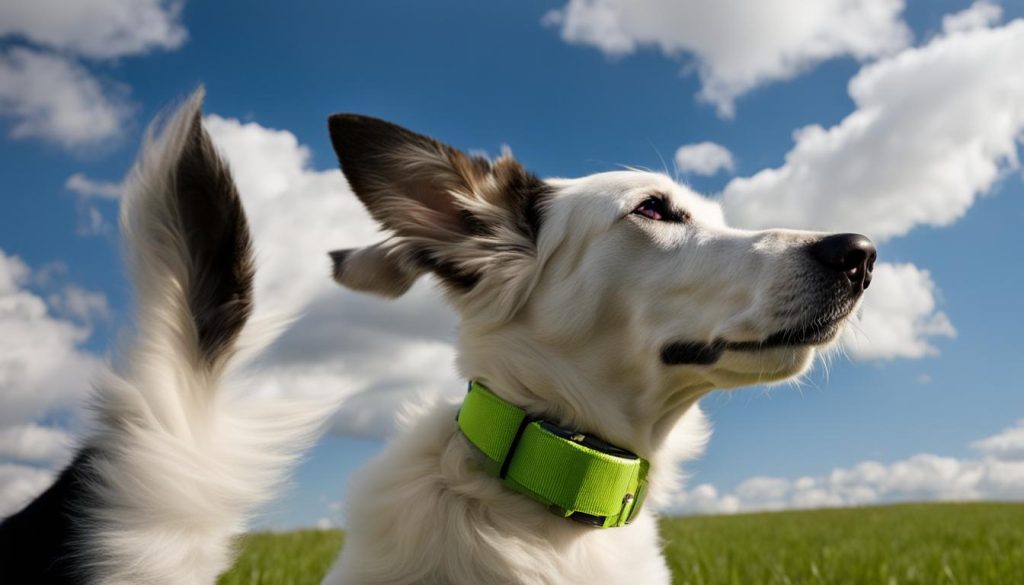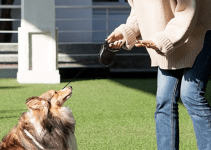Training a deaf dog requires a unique approach that takes into consideration their sensory limitations. By adapting traditional training techniques and using visual cues such as hand signals or body language, you can effectively communicate with your deaf dog and teach them important commands. In the following guide, we will delve into essential deaf dog training principles and methods, as well as discuss the importance of consistency and patience throughout the process. Let’s begin!
How to Train a Deaf Dog
- Deaf dogs can be trained effectively with visual cues and consistent communication methods.
- Hand signals play a crucial role in relaying commands to your deaf dog.
- Positive reinforcement is vital in motivating and teaching your deaf dog.
- Creating a safe environment for your deaf dog is essential for their well-being and training success.
- Patience and understanding are key factors in working through behavioral challenges and setbacks.
- Deaf dogs can excel in dog sports and learn complex tricks through appropriate training techniques.
- Consistency in training methods is important for the long-term success of your deaf dog.
1. Understanding Your Deaf Dog’s World
Deafness in dogs does not impede their cognitive, emotional, or social capabilities. They can compensate for the lack of hearing with their sharp sense of smell and sight, as well as their nuanced body language. Training a deaf dog requires an understanding of their sensory world, embracing the use of vibrations, gentle touch, light, or laser pointers as means of getting the dog’s attention and cues for training.
Adapting to Their Sensory Experience
Teaching commands to a deaf dog involves being aware of their unique sensory experiences. Instead of relying solely on sound, you should utilize different methods such as vibrations or gentle touch to get your dog’s attention. For example, stomping on the ground can create vibrations that they can feel, allowing them to recognize when you are trying to communicate with them. In addition to this, using light or laser pointers can be an effective way to guide their attention toward specific areas, objects, or actions.
Embracing Their Unique Learning Style
Adapting training methods for deaf dogs is essential in ensuring their success and happiness. A deaf dog may rely more heavily on their sight and smell, which should be capitalized upon during training. For instance, using high-value treats as a reward not only provides positive reinforcement for deaf dogs but also allows you to fully utilize their keen sense of smell.
One effective training technique is lure-and-reward training. This method involves utilizing a treat or favorite toy to guide your dog into a desired position or behavior, which can then be marked with a visual cue such as a thumbs-up gesture. Over time, your dog will associate this visual cue with the desired action, enabling them to respond correctly without the need for a lure.
Another useful technique is mark and reward training, which involves pairing a visual cue with positive reinforcement. For example, after successfully performing a command, use a hand signal (like a thumbs-up) to mark the behavior, and then reward your dog with a treat or praise. Consistency and repetition are crucial when it comes to training tips for deaf dogs, as they help to reinforce these visual commands and foster effective communication between you and your dog.
2. The Importance of Visual Communication
Developing a set of clear and consistent visual signals is crucial for training a deaf dog, as they rely entirely on sight to follow commands. The “watch me” sign is a foundational cue that keeps the dog’s attention on the trainer, ensuring effective communication and understanding between them. Using hand signals for deaf dogs enables the interpretation of commands and can be paired with vibrations from stomping, gentle touches, or visual markers like light flashes for optimal effectiveness during training.

One of the key communication methods for deaf dogs is using hand signals that are distinct and easy to understand. By consistently using these signals, trainers create a reliable form of communication that the dog can learn to recognize and follow. Hand signals also help foster a sense of partnership between the owner and their deaf dog, contributing to a strong bond and a happy, well-trained pet.
Furthermore, it is important to be patient and understanding while teaching these signals to a deaf dog. Consistency is key, and trainers should use the same visual cue for specific behaviors to prevent confusion. In time, the dog will start associating the hand signals with the desired action, resulting in a successful training experience.
3. Establishing Basic Commands with Hand Signals
Training deaf dogs requires the use of hand signals to establish basic commands. These gestures need to be clear, uncomplicated, and distinct enough from one another to prevent confusion. Consistency in implementing the chosen signals is a critical aspect of successfully teaching commands to a deaf dog. There are several options for trainers to choose from, including American Sign Language, traditional obedience gestures, or inventing their own unique signals that correspond to specific behaviors.
Choosing Clear and Consistent Signs
Selecting the right signs for a deaf dog’s training program is a careful process. The chosen gestures should be easy for the dog to recognize and differentiate from others, ensuring that communication between the owner and the dog is as smooth as possible. Experimenting with different hand signs and selecting those that yield the best results is an essential part of fine-tuning your training techniques for deaf dogs.
From Sit to Stay: Building a Sign Language Vocabulary
Developing a comprehensive sign language vocabulary for a deaf dog can be achieved through the lure-and-reward training method. This approach enables trainers to naturally evolve the lure movement into a hand signal as the lure is gradually phased out. For example, luring a dog into a sitting position using a treat above its head can later be transitioned into a distinct hand signal, representing the command “sit”. As with standard verbal training, building this sign language vocabulary will require a gradual progression from simple to more advanced commands.
4. Positive Reinforcement: The Key to Training Success

Positive reinforcement is a superior method for training any dog, but it is especially crucial for a deaf dog. This approach involves rewarding desired behaviors immediately after they occur, using hand signals, like a thumbs-up gesture, to mark the behavior before presenting the treat. Rewards should be highly valuable and varied to maintain the dog’s motivation and attention.
Repetition and consistency in utilizing this positive feedback will encourage the dog to repeat the desired behaviors. It is important to remember that deaf dog training requires patience and understanding, as they may take a little longer to learn new commands than their hearing counterparts. By building trust and a strong bond with your deaf dog, you will pave the way for a more successful training experience.
Overall, implementing positive reinforcement for deaf dogs not only fosters a more effective learning environment but also creates a stronger relationship between you and your four-legged friend. Keep in mind that every dog is unique, and finding the right reward system for your deaf dog is essential for achieving training success.
5. Creating a Safe Environment for Your Deaf Dog
Adapting training methods for deaf dogs involves not only adjusting the way you communicate, but also ensuring that their environment is safe and nurturing. As a pet owner, you play a significant role in providing a secure space for your deaf dog, enabling them to thrive and learn effectively.
Startle Prevention and Creating Positive Associations
One crucial aspect of creating a safe environment for your deaf dog is minimizing the risk of startling them. Since deaf dogs cannot hear your approach, it’s essential to desensitize your dog to unexpected touch and create positive associations with such instances. Gently touch your dog in a consistent location, such as on their back or shoulder, and reward them with praise or treats after contact. This process builds trust and reduces the likelihood of a startle response, ensuring that your deaf dog feels comfortable and safe.
In addition to touch desensitization, consider introducing vibrations as an alternative method for getting your dog’s attention or issuing commands. While deploying this technique, remember always to reward positive responses, making the dog more comfortable with these new types of stimuli.
Supervision is another crucial aspect of creating a safe environment for your deaf dog. When your dog is off-leash, make sure to keep an eye on them, making it easier to communicate when needed and prevent any potential mishaps. It’s also essential to educate friends, family members, and visitors about your dog’s condition. Inform them about the best ways to approach and interact with your deaf dog, so they can understand their unique needs and avoid potential hazards.
Creating a safe and accommodating environment for your deaf dog plays a significant role in their training and overall well-being. By employing startle prevention techniques, adapting your dog to new stimuli, supervising their activities, and educating others, you can lay a solid foundation for a long-lasting, fulfilling relationship with your deaf canine companion.
6. Dealing with Behavioral Challenges and Setbacks
When embarking on the training journey with your deaf dog, it’s crucial to understand that you may encounter some behavioral challenges and setbacks along the way. Just like with any dog, deaf dogs have their unique personalities and quirks, which may lead to moments of frustration or confusion during training. The key to overcoming these challenges is adopting an attitude of patience, empathy, and a willingness to modify your training strategies as needed.
To better manage these setbacks, I can’t emphasize enough the importance of staying positive and maintaining consistent, clear communication with your deaf dog. As their trainer, you play a pivotal role in building their confidence and developing trust. To achieve this, make sure to approach each training session with optimism and enthusiasm. Your energy will resonate with your dog and create a more engaging and effective learning environment.
It’s vital to recognize when your deaf dog is struggling with a certain aspect of training and take the necessary steps to address the issue. It could be that they are having difficulty distinguishing between two similar hand signals or are not motivated by the rewards you’re offering. Whatever the challenge, take a step back and reassess your training strategy.
Incorporating different training tips for deaf dogs can go a long way in helping you deal with setbacks more efficiently. For example, if your dog is struggling to grasp a certain command, try breaking it down into smaller steps or experimenting with different visual cues. Keep in mind that repetition is your friend, and it may take a few extra tries before the command fully clicks with your dog.
Finally, never forget that dealing with behavioral challenges in deaf dogs is a normal part of the training process. It’s essential to remain patient, understanding, and willing to change your tactics when needed. By doing so, you’ll create a strong foundation for a successful training journey and a lasting bond between you and your deaf dog.
READ: Guide: How to Teach a Dog to Speak – Simple & Fun Steps
Conclusion
Understanding how to train a deaf dog requires adapting your approach to account for their sensory limitations and embracing their reliance on visual cues. It’s essential to create a safe and comfortable environment tailored to their unique needs. Employing training techniques for deaf dogs that emphasize visual communication, such as hand signals and body language, allows you to build a strong bond and ensure their success in learning commands and behaviors.
Positive reinforcement for deaf dogs is crucial in fostering a successful training process. By appealing to their senses of sight and smell and rewarding desired behaviors with treats, praise, or play, you help to reinforce your messages and maintain their motivation. Patience, consistency, and understanding throughout the entire training journey are essential in supporting your deaf dog’s progress.
In summary, training a deaf dog involves adapting traditional methods to emphasize visual cues and a strong focus on positive reinforcement. By acknowledging the unique challenges and sensitivities of your deaf dog, cultivating patience and understanding, you can help them live a fulfilling life and experience the joy of a deep connection with their owner.
FAQ
How do I communicate commands to my deaf dog?
Communication with a deaf dog relies on visual cues, such as hand signals or body language. You can use American Sign Language, traditional obedience gestures, or create personalized signs for specific commands.
How can I get my deaf dog’s attention for training?
You can use vibrations, gentle touch, light flashes, or laser pointers to get your deaf dog’s attention. Start by teaching them the “watch me” sign to ensure they focus on you during training.
What is positive reinforcement, and why is it important for deaf dog training?
Positive reinforcement is a training method that rewards desired behaviors immediately after they occur. This approach is especially crucial for deaf dog training as it helps maintain their motivation and attention during training sessions. Use hand signals, like a thumbs-up gesture, to mark the behavior before giving a treat or reward.
How do I establish basic commands using hand signals for my deaf dog?
Select clear, consistent, and distinct gestures for each command. You can choose from American Sign Language, obedience gestures, or create your own signals. Use lure-and-reward training to naturally evolve a lure movement into a hand signal as the treat is faded out.
How can I prevent my deaf dog from getting startled?
Startle prevention involves desensitizing your deaf dog to unexpected touch and creating positive associations with such situations. Reward your dog after touching it gently in a consistent location to build trust and reduce their startle response. Supervising off-leash activities and educating others about your dog’s deafness can also help prevent startling situations.
How do I deal with behavioral challenges and setbacks while training my deaf dog?
Addressing behavioral challenges requires patience, understanding, and adjustments to your training approach. Recognize that each deaf dog is unique and may experience frustration or confusion. Remain positive, adjust your training strategies, and provide consistent and clear communication to manage behavioral issues effectively.






